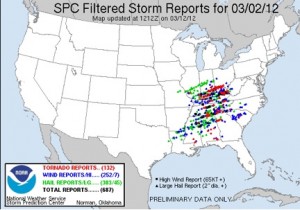This week, we have a guest blogger. Ashley Kaepplinger is currently working on her master’s degree in Meteorology at Florida State University and will finish in the summer of 2012. After she receives her master’s degree, she will begin working on her doctorate in Curriculum and Instruction. Ashley’s hobbies include anything that has to do with the outdoors, including fishing, hiking, kayaking, camping, and the weather. She is excited to be sharing her passion of weather and climate change in the GLOBE Scientists’ Blog!
Growing up, I always heard sayings about months and the corresponding weather patterns. Some included “April showers bring May flowers” and then of course the one dealing with the month of March, “in like a lion, out like a lamb”. With this March beginning with a tornado outbreak throughout the Ohio River Valley (131 reported tornadoes on March 2nd), some may wonder, will it actually go out like a lamb? Is there any truth behind this saying, or is it just a phrase society has been hooked on?

NOAA's Storm Prediction Center reports for the March 2, 2012 tornado outbreak. Image courtesy of SPC http://spc.noaa.gov/climo/reports/120302_rpts_filtered.gif
When we examine March in terms of weather events, there is a large amount of variability. In the northern hemisphere, March is a transitional period between the seasons with winter exiting and spring entering. The transition between the two seasons is what causes March to have its variability in terms of weather phenomena. Growing up in northern Illinois in the central United States, I remember having Spring Breaks with snow falling and others with temperatures warm enough to do outdoor activities. That is a substantial difference in terms of weather from year to year. The transition period can be observed when the seasons change between winter and spring; it does not matter your location. However, it can be more prevalent in regions with a more drastic change in the seasons opposed to regions that have the same weather variations throughout the year.
With the transition causing so many differences from year to year, it is hard to say, “in like a lion, out like a lamb” is always accurate. Although it can be true some years where the beginning and end of March are considerably different. In Illinois, the end of March is generally very pleasant. Temperatures are getting warmer, the snow is melting, and there isn’t much variability in temperatures over a few days. That is because spring is beginning to settle in and winter has exited. Don’t forget, spring is still an active period for weather patterns, as it marks the beginning of the severe weather season in most locations.
Using your GLOBE data, how many years do you have with March that comes in like a lion and out like a lamb? How many years are there that have no considerable change? Do you believe March usually comes in like a lion and out like a lamb? Try it out for yourself. And, what other weather phrases have you heard? Add a comment or send an email at science@globe.gov to let us know.
- Ashley Kaepplinger

Here’s one for May: The world’s favorite season is the spring.
All things seem possible in May.
how many years do you have with March that comes in like a lion and out like a lamb? .. its seems not easy to answer